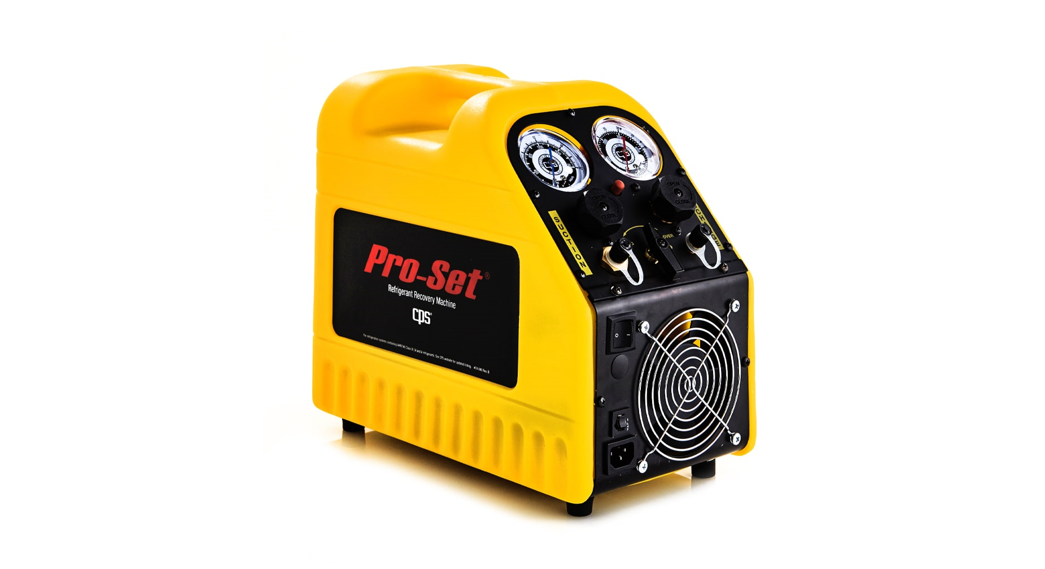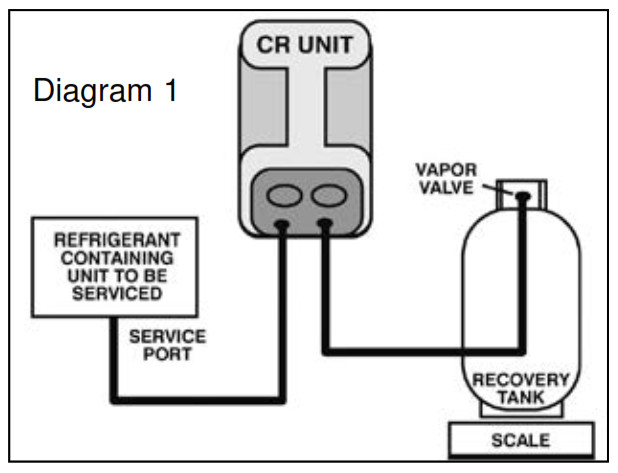
OIL-LESS REFRIGERANT RECOVERY SYSTEM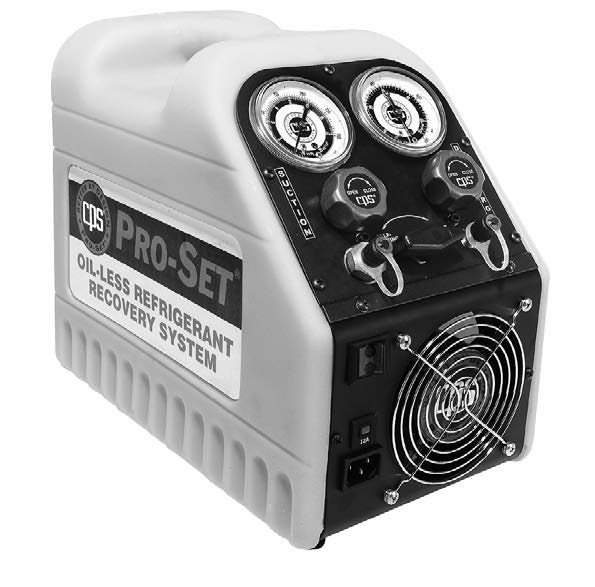 MODEL CR500 SERIES
MODEL CR500 SERIES
TO BE OPERATED BYQUALIFIEDPERSONNEL ONLY!This equipment has been certified by Underwriter Laboratories (UL) to meet or exceed EPA regulations per ARI 740-95 for refrigerants 12, 134a, 22, 500 and 502.See Specifications for a complete list of refrigerants.OPERATION MANUAL
INTRODUCTION
Thank you for purchasing the CPS ® PRO-SET ® CR500 refrigerant recovery machine. Like any CPS ® product, the CR500 series machines combine the latest in product technology with the practical “hands-on” features that our customers actively request. Focusing on product performance, recovery speed, and reliability, we were able to develop the most advanced oil-less recovery machines on the market today!Designed to service commercial/residential refrigeration and air-conditioning systems, the PRO-SET ® CR500 is the lightest most compact refrigerant recovery machine in its class. A convenient “QUICK START GUIDE” is permanently attached to the side of the unit and acts as a quick and easy reference for the proper operation of the unit. Once the recovery is complete, simply turn the center valve to the SELF-CLEARING position to automatically remove any residual refrigerant left in the machine. The unit is now ready to recover the next refrigerant type. The PRO-SET® CR500 series utilizes a 1/3hp/0.75kW oil-less compressor, non-restrictive manifold valves and a high-efficiency rifle-fin condenser/evaporator combination for quick and easy refrigerant recovery. Additional features include:
- EXTREMELY LIGHTWEIGHT: unit weighs less than 20 lbs/9.1 kg
- HIGH PERFORMANCE integrated fan
- “ON THE RUN” SELF-CLEARING VALVE: No need to turn the unit off when switching from recovery to self-clearing.
- BUILT-IN FILTER: located under intake port. No dangling filters to damage.
- FILTER CARTRIDGE can be easily cleaned or replaced
- R-410A COMPATIBLE: Special high-pressure unit design with extended pressure gauge ranges.
- HIGH-EFFICIENCY rifle-fin condenser/evaporator
- INTEGRATED MANIFOLD BLOCK BODY
- On-Board suction and discharge gauges
- INDESTRUCTIBLE high-density polyethylene case
- HEAVY-DUTY powder coated aluminum chassis
- COMFORTABLE integrated carrying handle
- 550 psig High-pressure cutout
- MAINTENANCE FREE oil-less compressor
- OPTIONAL TANK OVERFILL SENSOR cord kitTo help you get a good start, please continue to read the balance of this manual. It contains important information on the operation, maintenance, and safety issues you should thoroughly understand before attempting to operate the CR500 series machine. We recommend that you pay close attention to the safety information, WARNINGS, and CAUTIONS located throughout this manual. Always remember, “Safety First.”
UNIT CONSIST OF:
•PRO-SET®model CR500 • Power Cord Set (110volt version only) • Operation Manual •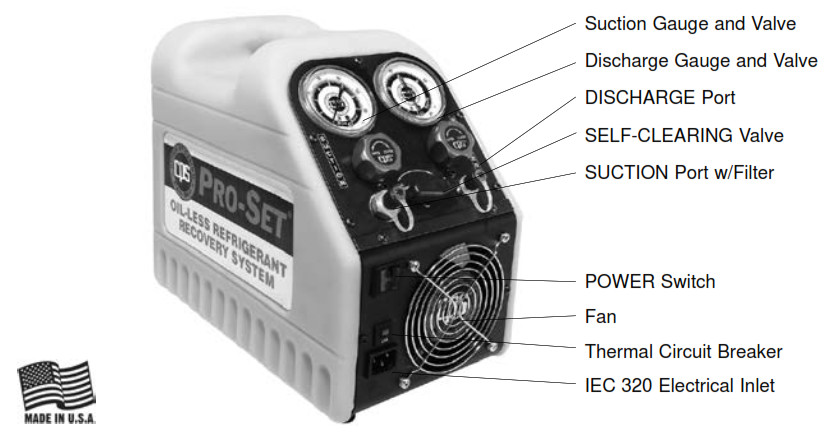
GENERAL SAFETY INSTRUCTIONS
ONLY QUALIFIED SERVICE PERSONNEL SHOULD OPERATE THIS UNIT. MOST STATES, COUNTRIES, ETC… MAY REQUIRE THE USER TO BE LICENSED. PLEASE CHECK WITH YOUR LOCAL GOVERNMENT AGENCY.DANGER – the recovery tank contains liquid refrigerant. Overfilling of the recovery tank may cause a violent explosion resulting in severe injury or even death.As a minimum use a scale to continuously monitor the recovery tank weight.DANGER – Avoid breathing refrigerant vapors and lubricant vapor or mist. Breathing high concentration levels may cause heart arrhythmia, loss of consciousness, or even cause suffocation. DANGER – ELECTRICAL SHOCK HAZARD Always disconnect the power source when servicing this equipment.DANGER – EXPLOSION RISK. Do not recover flammable refrigerants.CAUTION – all hoses may contain liquid refrigerant under pressure. Contact with refrigerants may cause frostbite or other related injuries. Wear proper personal protective equipment such as safety goggles and gloves. When disconnecting any hose, please use extreme caution.CAUTION – avoid breathing refrigerant vapors and/or lubricant mist. Exposure may irritate eyes, nose, throat, and skin. Please read the manufacturer’s Material Safety Data Sheet for further safety information on refrigerants and lubricants.CAUTION – To reduce the risk of fire, avoid the use of extension cords thinner than NO. 14 awg. (1,5mm2) to prevent the overheating of this cord please keep the length to a minimum.CAUTION – do not use this equipment in the vicinity of spilled or open containers of gasoline or other flammable substances. Make certain that all safety devices are functioning properly before operating the equipment. This equipment is intended for use of one refrigerant at a time until the SELF-CLEARING feature is used. Mixing different refrigerants will cause your recovered supply of refrigerants to become contaminated. NOTE: It is very expensive to destroy mixed or damaged refrigerants.
![]()
CR500 SERIES SPECIFICATIONS
| CR500 – CR500J – CR500S | |
| Compressor Type | 1/3 HP Oil-less Reciprocating Compressor |
| Dimensions | 20cm (8 ) wide x 37cm (14.5″) long x 30.5cm (12″) high |
| Weight | 9.1 kg (20 lbs.) |
| Operating Temperature Range | 0°C (32°F) to 49°C (120°F ) |
| Power Source | 115 VAC 50/60Hz 1Ph -100 VAC 50/60Hz 1Ph 220-240 VAC 50/60Hz 1Ph |
| Power Consumption | 500 W |
| Suction Pressure Gauge | -30″hg vac to 500 psig- -0.1 -3.5 mPa -30″hg vac to 500psig |
| Discharge Pressure Gauge | 0 to 800 psig – 0 -5.5 mPa 0 to 800 psig |
| Filtration | Cleanable 100-mesh screen integrated into Suction Port |
| Shut-off Valves | Both Suction and Discharge manifold ball valves |
| Construction | Heavy-gauge aluminum chassis with High-Density Polyethylene Case |
| Overload Protection High-Pressure Shut-off | 10A thermal circuit breaker 5A thermal circuit breaker550 psig |
| Refrigerants | R-12, R-134a, R-401C, R-406A. R-500. R-401A R-409A, R-401B, R-412A, R-411A, R-407D, R-22 R-411B, R-502, R-407C, R-402B, R408A, R-509 R-407A, R-404A, R-402A, R-507. R-407B, R-410A |
| Direct Vapor | Flow RateUp to 1.00 lb./min |
| Direct Liquid | Up to 2.50 lb./min |
| Push-Pull Liquid | Up to 11.00 lb./min |
DIRECT VAPOR OR LIQUID RECOVERY OPERATION
1. Connect the unit as shown in Diagram 1.2. Open the vapor valve on the Recovery Tank.3. Open DISCHARGE valve on CR unit.4. Rotate the center valve to the “RECOVERY” position.5. Turn the power switch to the “ON” position.6. Once a unit has started, open the SUCTION valve on the CR unit to start the refrigerant flow.NOTE: If the liquid refrigerant is present, a hammering sound will come from the compressor. Use the SUCTION valve to meter or regulate the incoming refrigerant until the hammering sound goes away. The SUCTION gauge will read the regulated pressure to the compressor.7. Monitor the suction gauge until it falls below the required vacuum level.8. Rotate the center valve to the SELF-CLEARING position. Again monitor the suction gauge. Once the gauge reads a vacuum, Close the SUCTION valve, turn the unit OFF. RECOVERY AND SELF-CLEARING ARE COMPLETE.
PUSH-PULL LIQUID RECOVERY OPERATION

1. Connect the unit as shown in Diagram2.2. Open both valves on the Recovery Tank.3. Open DISCHARGE valve on CR unit.4. Rotate the center valve to the “SELF-CLEARING” position.5. Turn power switch “ON” position.6. Once a unit has started, open the SUCTION valve on the CR unit to start the refrigerant flow.7. Monitor the optional inline sight glass for liquid refrigerant movement.8. Once the liquid refrigerant is no longer present, close the recovery tank vapor valve. When the SUCTION gauge falls into a vacuum close the SUCTION valve and turns the unit OFF.PROCEED TO DIRECT VAPOR RECOVERY OPERATION.
ROUTINE MAINTENANCE
FILTER MAINTENANCE – the CR SERIES is equipped with a 100 mesh screen filter. This filter should be checked periodically. A partially clogged filter will slow down the recovery rate of this unit.Replace the filter cartridge as follows:
- Use a 7/8” socket or boxed end wrench to loosen the suction port as shown in Figure 1.
- Once loose, remove the suction port- filter cartridge assembly is shown in Figure 2.
- Either clean the current cartridge or replace it with a new cartridge. (Item NO. CRXF3)
- Inspect O-RING. RE-LUBRICATE with compressor oil or equivalent.
- Place the filter back into suction port fitting.
- Hand tightens this assembly back onto the CR unit.
- Use a 7/8” socket or boxed end wrench to tighten 1/8 of a turn. DO NOT OVERTIGHTEN, damage to the O-RING may occur.
- Check the connection for leaks.
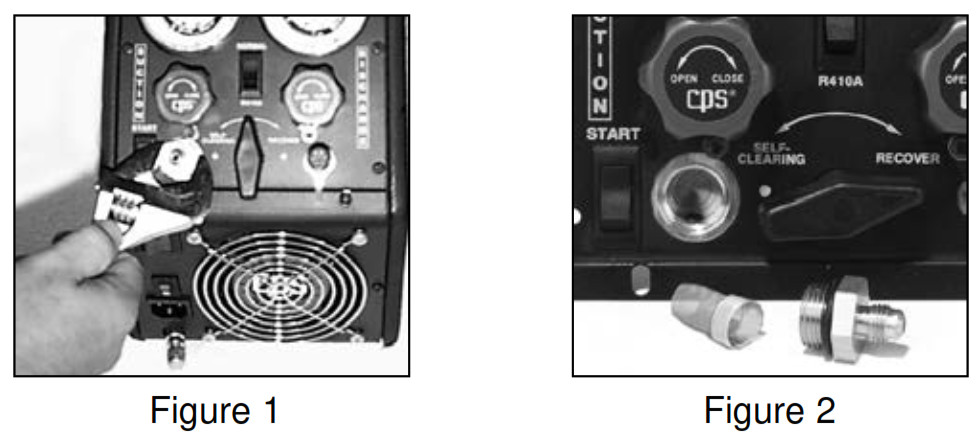
TROUBLESHOOTING CHART
PROBLEM: The unit will only pull down to 0 pressure or a slight vacuum.SOLUTION: Remove refrigerant hose from Suction port. Place a cap on this port:1. If the unit pulls a vacuum, then the low side leak is somewhere between the refrigerant hose and the equipment being recovered.2. If the unit does not pull a vacuum, then suspect an internal low side leak on the CR unit.
PROBLEM: The unit starts for a few minutes, then shuts off.SOLUTION: The high-pressure switch has activated. Make sure the discharge valve is open. Make sure the recovery tank valve(s) are open. Check for any other restrictions on the discharge port of the unit. Correct restriction. Restart the unit.
PROBLEM: The unit does not start and the thermal circuit breaker activates.SOLUTION: If the unit fails to start, open the suction valve and rotate the center valve to the “SELF-CLEARING” position for 5-10 seconds.Then rotate back to the “RECOVERY” position. Reset circuit breaker. Push the START switch.
PROBLEM: The unit recovers at a very slow pace.SOLUTION: Check the suction port filter. Replace or clean.
HELPFUL HINTS
- If the refrigerant to be recovered is from equipment with high contamination levels of acid, moisture, etc.… it is recommended to utilize an in-line filter drier placed before the suction port of the CR600 unit. An Alco EKO52 or equivalent filter drier would provide adequate protection.
- If a large amount of liquid refrigerant (greater than 70lbs.) is present, it would be recommended that the Liquid Push-Pull method be performed first, then follow by Direct liquid or vapor recovery.
- A ball valve or an anti-blow fitting should be used on the end of the discharge hose. This will prevent unnecessary loss of recovered refrigerant. It will also protect the user from liquid refrigerant contact. Read General Safety instructions on refrigerant contact.
- When recovering refrigerant under low ambient temperature conditions, add heat o devices such as receivers, accumulators, etc…. to help vaporize the refrigerant. This will greatly speed up the recovery process.
Learn more about the automotive A/C tools and equipment we have.
[xyz-ips snippet=”download-snippet”]

